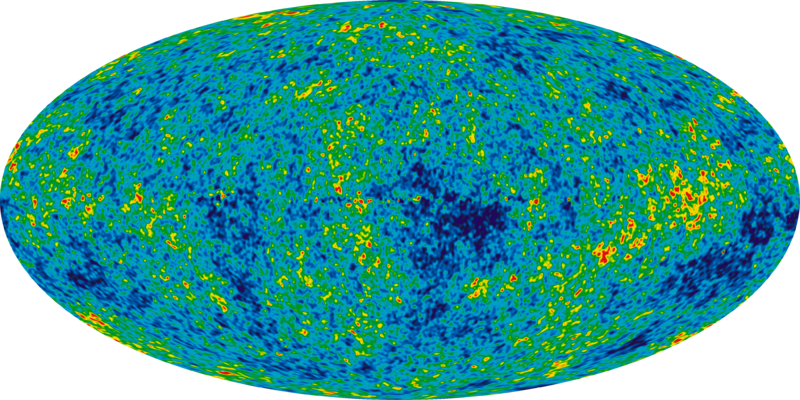What’s the Evidence for the Big Bang? NASA, theoretical physicist Lawrence Krauss, et al., say it’s the theory’s confirmed predictions.
The Big Bang’s Failed Predictions and Failures to Predict: As documented below, the repudiation of the predictive ability of the big bang includes its many failures.
 – the theory’s failed prediction of an entire universe worth of antimatter
– the theory’s failed prediction of an entire universe worth of antimatter
– the failure to predict the universe worth of dark matter needed if the BB is correct
– the 2.7K CMB background radiation and the missing shadow of the CMB
– 2014’s claimed discovery of gravity waves, i.e., inflation’s smoking gun
– failed to predict inflation, another BB rescue device of questionable predictive value
– the claimed initial abundances of the elements hydrogen, helium and lithium
– failures with magnetic monopoles and the transparency problem
– expansion, by post-dating expansion discovery and by pre-dating the big bang, only then could the theory “predict” expansion.
The Physicists Contradicting the Alleged Confirmations of the Big Bang: To repudiate the widely-repeated claim that the big bang theory has been validated by confirmed predictions, Real Science Radio hosts Bob Enyart and Fred Williams present to The Creation Club direct testimony from:
– leading journals like Nature, Physics Letters Review, and The Astrophysical Journal
– a Nobel scientist who won the prize for the discovery of the CMB
– distinguished professors of physics from prestigious institutions like Princeton
– America’s premier particle physics lab, Fermi National Accelerator Laboratory
– Cambridge University’s Modern Cosmology, Science News and New Scientist
– Alan Guth, the father of inflation theory, and from creationist physicists, and from
– hundreds of relevantly degreed scientists, including many from leading institutions.
If the following contrary-to-interest expert testimony from leading big bang advocates is accurate, then Lawrence Krauss (A Universe from Nothing, p. 18, and on Real Science Radio) is wrong when he, along with ten thousand others, claims that confirmed predictions validate the big bang.
Failed Antimatter Prediction and Failed Dark Matter Search: Scientists have identified two entire universes worth of failure in the predictions of big bang theory, regarding both its erroneous antimatter prediction and its failure to either predict, or detect, dark matter. If the big bang has actually occurred, transforming vast energy into all of the matter of the universe, then that would have created as much antimatter as matter. Extensive compelling scientific investigation including repeatable experiments suggests that there is an entire cosmos worth of antimatter that should have been created by the big bang within our universe that, thankfully, simply does not exist. When supercolliders form matter from energy, as expected from the laws of physics, equal parts of matter and antimatter form; and if they come into contact, they annihilate one another. Big Bang theorists have spent decades looking for antimatter regions of the universe with leading astronomers culminating a significant project by writing in The Astrophysical Journal: “we conclude that a matter-antimatter symmetric universe is empirically excluded.” The journal Science reports a physicist’s assessment: “The work is extremely compelling and gives me fresh pessimism” that is, on the difficulty of explaining why the universe even exists. For a creationist and a secular explanation of this problem, see creation.com’s report on the Discovery Channel’s How the Universe Works, and see this Fermilab antimatter video:
Further, regarding the hypothetical entities dark matter and dark energy (not to mention inflatons and dark radiation), which are believed in to save the big bang theory from millions of actual astronomical observations which otherwise contradict it, although they are claimed to make up 95% of the entire universe, the big bang also failed to predict these. (Consider an economic prediction for Barack Obama’s presidency that missed deficit spending. How accurate is a model that claims it missed 95% of the picture?) And intense searches for dark matter, like in the closest 13,000 light-year swath of the galaxy, turn up empty. Thus, in addition to its many other failed predictions (as we shall see), the big bang’s failure to predict nearly 100% of the alleged matter of the universe is in addition to its failed prediction of 100% of the universe-worth of antimatter.
Now consider the standard model’s track record regarding the CMB, with one of the very scientists who won the Nobel prize for its discovery attempting to dial back the credit given to the big bang for that discovery.
Alleged Confirmed Prediction of CMB: One of the scientists credited with discovering the cosmic microwave background disagrees with big bang advocates like Lawrence Krauss when they claim that the CMB “prediction” is a confirmation of the validity of that model. Compare what NASA says about this to the Nobel lecture of one of those awarded the prize for discovering the CMB. Notice the three claims, existence, blackbody, and temperature, from NASA’s Test of the Big Bang article:
The important [BB] prediction that the cosmic microwave background (CMB) exists, and has a blackbody spectrumwith a temperature of about 5 degrees above absolute zero, was a by-product of this work [Alpher & Herman, working under and disagreeing with George Gamow].
Now, in the lecture given by Robert Wilson on the very occasion of sharing the 1978 Nobel Prize for discovering in 1964the cosmic microwave background, notice that those same three elements had been previously indicated by long-published data. For Wilson admitted:
The first confirmation of the microwave cosmic background that we knew of, however, came from a totally different, indirect measurement. This measurement had, in fact, been made thirty years earlier by [Mount Wilson Observatory’s] Adams and Dunhan [see Wilson’s references, dated 1937-1941]… from the first rotationally excited state. McKellar [reference] using Adams’ data… calculated [via absorption lines from cyanide detected in outer space] that the excitation temperature of CN was 2.3 K. This rotational transition occurs at 2.64mm wavelength, near the peak of a 3 K black body spectrum. [Wilson, Nobel Lecture, see more…, and see Arno Penzia’s lecture]
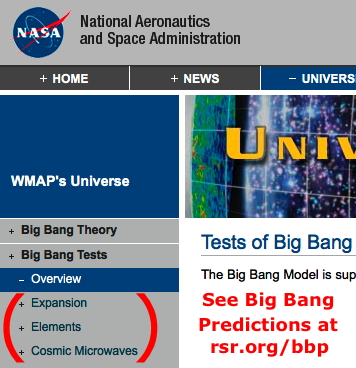 So even though Wilson made it clear on the record that this “prediction” really could only be a retrodiction because published empirical observations first began to detect it a decade prior to its 1948 “prediction” (see next quote), the canonical BB narrative insists on a revisionist twist. For NASA’s official Test of the Big Bang article claims:
So even though Wilson made it clear on the record that this “prediction” really could only be a retrodiction because published empirical observations first began to detect it a decade prior to its 1948 “prediction” (see next quote), the canonical BB narrative insists on a revisionist twist. For NASA’s official Test of the Big Bang article claims:
The existence of the CMB radiation was first predicted by Ralph Alpher in 1948 in connection with his research on Big Bang Nucleosynthesis undertaken together with Robert Herman and George Gamow. … According to the Big Bang theory, the frequency spectrum of the CMB should have this blackbody form. This was indeed measured with tremendous accuracy… The accurate measurement of its shape was another important test of the Big Bang theory.
The prediction though was of what was already known to exist. The theorists in 1948 were merely conforming the model to data already collected from 1937 to 1941. Then in the 1950s George Gamow, an early BB proponent and his students Alpher and Herman, made additional predictions of the CMB temperature that ranged from 3 to 50 degrees Kelvin. So even after the data from the Mount Wilson observatory reported a temperature very close to actual, leading theorists were making some predictions [or retrodictions] that were close to the actual temperature, and others that were off by a factor of more than 10 universes.
That 1948 prediction for the CMB was 5 degrees Kelvin (Nature, Evolution of the Universe). This was close enough to the actual 2.73 K:
– for the other way off predictions (wrong by a factor of 10 universes) to be ignored
– for the more accurate, earlier, actual measurements to be mostly forgotten, and
– for the big bang to be considered experimentally confirmed.
Of course, such predictions were logically constrained by absolute zero and by the expected frigid temperature of outer space, and then specifically by the work of Adams and McKellar. Yet with all that, the published 1948 prediction was still off by nearly a full universe margin of error.
To quote Physics Essays in summary, Big Bang Theory Under Fire, regarding the CMB (aka the MBR):
“History also shows that some Big Bang cosmologists’ ‘predictions’ of MBR [microwave background radiation] temperature have been ‘adjusted’ after-the-fact to agree with observed temperatures.” Mitchell, pp. 370-379
Those after-the-fact claims for the theory are also extended generally from the CMB to, as seen below, the chemical elements also:
“What’s more, the big bang theory can boast of no quantitative predictions that have subsequently been validated by observation.” Eric Lerner et al., “Bucking the Big Bang”, New Scientist, Vol. 182, 22 May 2004, p. 20.
Therefore many relevantly degreed scientists working at prestigious institutions such as the Max-Planck Institute for Astrophysics, Jet Propulsion Laboratory at CalTech, Cambridge University, etc., have signed CosmologyStatement.org stating that:
…the big bang theory can boast of no quantitative predictions that have subsequently been validated by observation. The successes claimed by the theory’s supporters consist of its ability to retrospectively fit observations with a steadily increasing array of adjustable parameters…
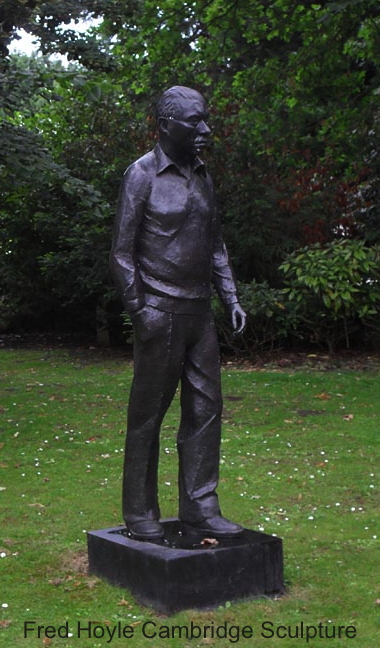 Fred Hoyle was president of the Royal Astronomical Society and was long the director of the Astronomy at Cambridge and . He fathered the theory of stellar nucleosynthesis which remains the concept that the secular world depends upon to explain the origin of 23 elements on the periodic table, from lithium to iron, including many of the elements needed for carbon-based lifeforms (like us). In 2000 Hoyle and two co-authors wrote:
Fred Hoyle was president of the Royal Astronomical Society and was long the director of the Astronomy at Cambridge and . He fathered the theory of stellar nucleosynthesis which remains the concept that the secular world depends upon to explain the origin of 23 elements on the periodic table, from lithium to iron, including many of the elements needed for carbon-based lifeforms (like us). In 2000 Hoyle and two co-authors wrote:
The cosmic microwave background first showed itself observationally to astronomers in the late 1930s and early 1940s… The excitating radiation was taken to be black body, and the temperature required for it, in order to explain the relative intensities of the observed lines, was 2.3 K.
While the Nobel lecture quote above from Wilson would have helped make their case, Hoyle et al. easily concluded even without it:
This detection of the microwave background was so very explicit that its discovery could quite properly be dated from 1941, if it suited astronomers to do so.
The information explosion has brought about a concerted effort in the history of science to reevaluate the chronology of scientific discovery. The credit given to those traditionally recognized as discoverers is now often shared with other less well-known forerunners. This historically valuable trend is noticeably resisted where politically correct origins theories are involved, as with the big bang and evolution. (Darwinists for example either downplay or ignore the scientific contribution of intelligent design advocate Alfred Russell Wallace who wrote to Charles Darwin in 1858 outlining Wallace’ theory of natural selection.) Regarding the big bang, the claim is too big to fail that it was confirmed by correctly predicting the CMB. So there we have it.
RSR thanks the courageous scientists who resist politically correct historical revisionism and we also thank the creation movement and especially Dr. Walt Brown for the determination to hold the secular cosmologists’ feet to the fire by exposing their unsubstantiated claims.
Finally regarding the CMB, note that the BB did not enable scientists to predict the significant and generally aligned anisotropies found in the CMB from 2001 to 2013, which were so contrary to the expectations of the materialist origins camp that it is referred to as the cosmic ‘axis of evil’; evil because it seems to point to the Earth as in a very special location.
Missing CMB Shadow of the Big Bang: As reported in Science Daily, University of Alabama at Huntsville scientist Dr. Richard Lieu concludes, “Either… the Big Bang is blown away or … there is something else going on’.” The Astrophysical Journal reported on a “vital test of the present cosmological paradigm” i.e., the big bang, that “taken at face value, one may even hold the opinion that there is in fact no strong evidence” for the long-predicted shadow of the CMB from behind 31 nearby galaxy clusters. As with dozens of some of the most careful and extensive observations ever made in the history of science, the missing shadow is yet another failure, not of an incidental off-the-cuff prediction but of a fundamental requirement of the big bang. As Dr. Lieu put it, “These shadows are a well-known thing that has been predicted for years. If you see a shadow… it means the radiation comes from behind the cluster. If you don’t see a shadow, then you have something of a problem.” See also the Royal Astronomical Society’s follow-up corroboration and hear RSR’s 2014 discussion with one of the world’s more successful physicists, at rsr.org/john-hartnett, that this hard data implies that the CMB may have a foreground source. Yet the BB remains a matter of deep faith among believers, as Dr. Lieu told space.com, “I myself am not at this point prepared to accept that the CMB is noncosmological and that there was no Big Bang. That would be doomsday.”
Prediction vs. Retrodiction. To avoid doomsday, the word “prediction” is widely misused in cosmology. An actual “prediction” is far different from a postdiction or a mere tweaking of a model to adjust it to meet existing requirements. A *prediction”, if confirmed, lends credibility to a theory. Adjusting a model so that it conforms to observations does not confer that same credibility. So big bang promoters use doublespeak knowing that their claim of confirmed “predictions” will persuade many, whereas truthful statements that the model has been adjusted after the fact to conform to observations would be far less compelling.
Inflation Theory’s Alleged Predictive Value, BICEP2, and Gravity Waves: In March of 2014 the science world and the non-creationist media ecstatically celebrated the big bang’s “smoking gun” with a premature announcement. The most fantastic rescue devices of any theory in the history of science, the “inflation period” hypothesis claims that the universe exanded by a factor of 1078 in a time of 10-30 seconds. Bob Enyart and Fred Williams opened their March 2014 program on RSR’s List of Evidence Against the Big Bang with a brief statement dismissing the uncritical reporting of the alleged confirmation. But within months, as Ron Cowan reported in the journal Nature:
“I had thought that the [BICEP2] result was very secure,” said Alan Guth, the cosmologist who first proposed the inflation concept in 1980… “Now the situation has changed,” added Guth, who works at the Massachusetts Institute of Technology in Cambridge.
While there was no big bang, nor any inflation period, gravity waves themselves if they existed would not inherently contradict creation. However, this episode illustrates the worldwide, knee-jerk tendency to claim success for big bang predictions. RSR is sad for Stanford physicist Andrei Linde, one of the authors of inflation, who was videotaped hearing the news of the Bicep2 “discovery”, who said:
Let us hope that this is not a trick. I always live with this feeling, what if I am tricked? What if I believe in this just because it is beautiful [i.e., a just-so BB theory rescue device]. What if…
 Yes, what if. Months later, after the September 2014 release of Planck satellite data on dust, the headlines stated:
Yes, what if. Months later, after the September 2014 release of Planck satellite data on dust, the headlines stated:
– Physics World: BICEP2 gravitational wave result bites the dust
– The Guardian: Scientists got it wrong on gravitational waves
– NewScientist: Ripples… vanish in a puff of dust
– Nat’l Geographic: Grand Cosmological Claim Crumbles? 25,000 times the readers of National Geographic clicked “Like” to promote the alleged confirmation of the big bang’s inflation period. But even many months after they reported the correction, only 51 of their readers similarly promoted the correction.
More significantly, the gravity wave hysteria also illustrates the lack of predictive value of what is essentially a speculation on top of a speculation, that is, the inflation period of the big bang. Also exposed was the extreme viewpoint bias and gullibility of the scientific community, of the secular media, and of the old earth progressive creationists (like at Reasons to Believe, where they are yet to add a caution on what they claim is proof of the non-existent inflationary period). Worse though than all that gullibility, is the infinite malleability of amorphous theories like biological evolution and like inflation and cosmological evolution. “Premature hype over gravitational waves” ignored the “serious flaws in the analysis” with the “proof” transforming itself from “sure detection into no detection” as Dr. Paul Steinhard wrote in June 2014 in anotherscathing article in Nature. The professor of physics at Princeton concluded:
The BICEP2 incident has also revealed a truth about inflationary theory. The common view is that it is a highly predictive theory. If that was the case and detection of gravitational waves was the ‘smoking gun’ proof of inflation, one would think that non-detection means that the theory fails. … Yet some proponents of inflation… insist that the theory is equally valid whether or not gravitational waves are detected. How is this possible? …inflation is [theoretically] driven by a hypothetical scalar field, the inflaton, which has properties that can be adjusted to produce effectively any outcome. … No experiment can rule out a theory that allows for all possible outcomes. Hence, the paradigm of inflation is unfalsifiable. …it is clear that the inflationary paradigm is fundamentally untestable, and hence scientifically meaningless.
A cosmologist from the Perimeter Institute for Theoretical Physics in Waterloo, Ontario has a similar view. Neil Turok, who once bet Stephen Hawking that gravitational waves would never be detected, also says: “One of its problems is it’s very adjustable. [Inflation theory] makes very few specific predictions that you could actually go out and check with a measurement.” And as with inflation, the entire Big Bang theory has a history of being wildly malleable.
Inflation Theory Not a BB Prediction But an Ad Hoc Secondary Assumption: Inflation was assumed to address the BB’s starlight travel time problem. Like the starlight and time challenge put to biblical creationists, the big bang has the same problem, known as its horizon problem. Even a 14-billion year old universe is nowhere near old enough to enable the temperature of the background radiation to even out so perfectly. So, just as dark matter was not a prediction of the BB, in 1981, not as a prediction of the big bang, but in an ad hoc, adjusting to the data, dramatic secondary assumption, Alan Guth imagined an inflation period in which space expanded at speeds far greater than the speed of light, to solve the problem of a big bang universe being far too homogenous (even temperature) to be explained by the most fundamental of the laws of thermodynamics. So, in addition to inflation 2014 gravity wave fiasco as explained just above, the proposed wildly rapid and astoundingly brief expansion of space has no known mechanism that would power and suddenly start the expansion. Also unsolved is the “graceful exit” problem of an equally sudden stop. Yet while this inflation was proposed to account for the smoothness of the universe, apparently, it resulted in a far too smooth universe to enable the formation of stars and galaxies! Thus, as a dramatic offsetting counter assumption, cosmologists have begun proposing dark matter bubbles to get densities of matter in the midst of all that inflated homogeneity. That is, while inflation was imagined to address the problem of the universe being too homogenous, to solve the exact opposite problem, dark matter bubbles have now been imagined because the extreme evenness of background radiation indicates that the universe was not lumpy enough to naturally form stars. An expanding universe exacerbates the problem that the laws of physics do not enable the natural formation of stars from gas clouds. So BB cosmologists call again upon the super malleable great-in-a-pinch dark matter to rescue their theory. It is now claimed that trillions upon trillions of dark matter bubbles (DMBs) allegedly formed in a just-so arrangement by way of the big bang so that each one would gravitationally attract gas to form the trillions of alleged Population III protostars. With all those DMBs formed, this tertiary assumption/rescue device also solves the problem of how galaxies formed, suggesting that DMBs were initially arranged into clusters which formed the galaxies. Imagined inflation and DMBs are such dramatic attempts to explain observations which otherwise bluntly falsify the standard model, that one can see that the big bang theory is as pliable as any science fiction holodeck could be.
Alleged Confirmed Prediction of Abundances of Elements: While most cosmologists reject that God could have created the universe in six literal days, they themselves believe that within 20 minutes of the big bang, all of its matter had been created, via big bang nucleosynthesis (BBN). The 2013 Planck cosmological parameters paper admits:
Observations [sic] of light elements abundances created during big bang nucleosynthesis (BBN) provided one of the earliest precision tests of cosmology and were critical in establishing the existence of a hot big bang.
Aside from the misuse of the term “observations” to refer to a belief of what happened in the past, note the helpful admission that the alleged elements confirmation was “critical” to acceptance of big bang theory. Before the era of “precision cosmology”, long ago in history back to the year 1990, a handful of scientists were determined to state for the record that the big bang theory had not predicted the relative abundances of hydrogen, helium, and lithium. Rather, they argued, big bang proponents were adjusting the theory’s parameters to match already existing observations:
“It is commonly supposed that the so-called primordial abundances of D (Deuterium, i.e., heavy hydrogen, N+P), 3He (Helium N+2P), and 4He (2N+2P) and 7Li (Lithium 3P+4N) provide strong evidence for Big Bang cosmology. But a particular value for the baryon-to-photon ratio needs to be assumed ad hoc to obtain the required abundances.” -H. C. Arp et al., 1990 Nature 346, pp. 807-812
[For more about the BB theory’s failed predictions of initial abundances, including for hydrogen, helium, lithium, beryllium, boron, and even monopoles, and for it’s “transparency problem”, see rsr.org/bbp. For now though, here at The Creation Club, let’s continue on to the fascinating discussion that corrects the false chronology used to prop up the canonical telling of the big bang story.]
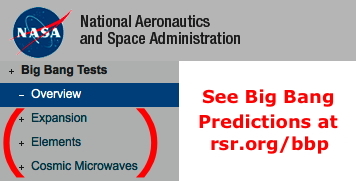 Expansion Claim Post-Dated; Big Bang Theory Pre-Dated: Lemaître first proposed the big bang in 1931. Yet presumably reliable sources pre-date it as being proposed in the 1920s (see National Geographic and dozens of other sources, just below). Conversely, the proposal of an expanding universe is frequently post-dated and falsely claimed to have originated with Edwin Hubble. At RSR, we like to debunk conspiracy theories, but these anachronisms form a canonical narrative. The revisionist big bang myth grew up as evidence for the theory. Proponents realize the persuasive value in their claim that the big bang theory actually predicted the expansion, the CMB, and the distribution of elements. However, simple links to the scientific papers from the 1920s and 30s (which links are typically absent from astronomy sites where one would expect them) easily restore the actual history.
Expansion Claim Post-Dated; Big Bang Theory Pre-Dated: Lemaître first proposed the big bang in 1931. Yet presumably reliable sources pre-date it as being proposed in the 1920s (see National Geographic and dozens of other sources, just below). Conversely, the proposal of an expanding universe is frequently post-dated and falsely claimed to have originated with Edwin Hubble. At RSR, we like to debunk conspiracy theories, but these anachronisms form a canonical narrative. The revisionist big bang myth grew up as evidence for the theory. Proponents realize the persuasive value in their claim that the big bang theory actually predicted the expansion, the CMB, and the distribution of elements. However, simple links to the scientific papers from the 1920s and 30s (which links are typically absent from astronomy sites where one would expect them) easily restore the actual history.
Consider this excerpt from NASA’s Test of the Big Bang article. The RSR comments in brackets highlight the obviously intentional sloppiness, for the canonical account of the big bang theory requires this kind of misrepresentation:
The Big Bang model was a natural outcome of Einstein’s General Relativity… [That’s misleading. The year after he published GR, Einstein added a constant to support his own view that a static universe had existed eternally. That constant can be arbitrarily valued as either positive, zero, or negative to obtain a repulsive, static, or attractive force that would tend toward expansion, a static, or a contracting universe.] However in 1917, the idea that the universe was expanding was thought to be absurd. [But by the time the BB was proposed in 1931, expansion was widely believed (see below).] So Einstein invented the cosmological constant as a term in his General Relativity theory that allowed for a static universe. [Notice how flexible this kind of cosmology is. The “success” of the big bang lies in its ability to simply conform to whatever the latest data or cosmological fad requires.] In 1929, Edwin Hubble announced that his observations of galaxies outside our own Milky Way showed that they were systematically moving away… [Statements like this reinforce the widely held falsehood that Hubble discovered expansion. As widely documented and shown below, published theoretical and observational considerations that pre-dated Hubble suggested that many galaxies are receding.] The universe was expanding after all, just as General Relativity originally predicted! [That’s flat-out misinformation. GR can support a static, contracting, or expanding universe.] … In other words, the Hubble law is just what one would expect for a homogeneous expanding universe, as predicted [retrodicted] by the Big Bang theory.
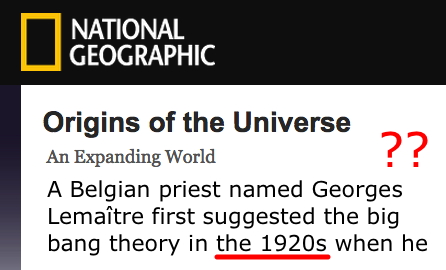 Pre-Dating the Big Bang to the 1920s: The Internet makes information so widely available that finally, in the second decade of the 21st century, the science press has begun to correct their erroneous post-dating of the proposed expansion of the universe (see below). As of 2015 however, only creationists are pushing to correct the pre-dating of the big bang theory. Joining many seemingly reliable sources, National Geographic wrongly dates the origin of big bang theory: “A Belgian priest named Georges Lemaître first suggested the big bang theory in the 1920s…” Lemaître [la-‘may-truh] however didn’t propose this cosmogony until May 1931, after Eddington, in the March issueof Nature that year, described the idea that the universe could have had a beginning as repugnant. Is National Geographic’s article simply a one-time chronological error? Sources that pre-date the theory from the 1930s back to the 1920s include the world’s leading particle accelerator lab, science texts, and encyclopedias:
Pre-Dating the Big Bang to the 1920s: The Internet makes information so widely available that finally, in the second decade of the 21st century, the science press has begun to correct their erroneous post-dating of the proposed expansion of the universe (see below). As of 2015 however, only creationists are pushing to correct the pre-dating of the big bang theory. Joining many seemingly reliable sources, National Geographic wrongly dates the origin of big bang theory: “A Belgian priest named Georges Lemaître first suggested the big bang theory in the 1920s…” Lemaître [la-‘may-truh] however didn’t propose this cosmogony until May 1931, after Eddington, in the March issueof Nature that year, described the idea that the universe could have had a beginning as repugnant. Is National Geographic’s article simply a one-time chronological error? Sources that pre-date the theory from the 1930s back to the 1920s include the world’s leading particle accelerator lab, science texts, and encyclopedias:
CERN, Encyclopedia of Inventions, DK’s Body Science,
American Physics Society Timeline, National Geographic,
Chemistry in Space text, Astronomy Top 100, University of Delaware,
Simon & Schuster’s Timetables, On Prezi,com Science 1920s,
a Public School District, Historical Encyclopedia of… Sciences,
Univ. of Toronto Survey of Philosophy, Templeton Foundation,
Astronomy Geek, New York Times, Michigan State University,
Omaha World-Herald, Mount Holyoke College,
Belgium’s Encyclopedia of Human Thermodynamics,
Concise Encyclopedia of World History, University of Amsterdam, King’s Academy, on Jeopardy at Quizlet, Trivia Bug, at Pintrest, Facebook, Tweeted, on CosmoQuest, etc., etc., etc., etc.,
etc., etc., etc., etc., etc., etc., etc., etc., etc., etc., etc., etc., etc., etc.
Charles Darwin jockeyed with a creationist named Wallace over who first discovered the theory of natural selection. Likewise, the earlier a theory is proposed, the more its insights could be credited with yet future discoveries.
 So, the true 1931 date of the big bang theory is not early enough for its story as commonly presented. Yet it was the May 1931 issue of the journal Nature that first published Georges Lemaître’s brief letter, less than half-a-page (see right) titled, The Beginning of the World form the Point of View of Quantum Theory. Can you spot the subtle revisionist errors in this brief encyclopedia entry that reinforces the false canonical story?
So, the true 1931 date of the big bang theory is not early enough for its story as commonly presented. Yet it was the May 1931 issue of the journal Nature that first published Georges Lemaître’s brief letter, less than half-a-page (see right) titled, The Beginning of the World form the Point of View of Quantum Theory. Can you spot the subtle revisionist errors in this brief encyclopedia entry that reinforces the false canonical story?
Historical Encyclopedia of Natural and Mathematical Sciences, p. 3763, “1927-1931 George Henri Lemaître (1894-1966, Belgium). Astronomer and cosmologist. Proposed that the universe was created by an explosion of concentrated energy and may still be expanding.”
First, the theory was proposed in 1931, not in 1927-1931. Second, it’s not evidence for expansion that could confirm the theory but rather it was the apparent expansion that led to the theory. And third, Lemaître did not propose the explosion of a “point” nor of “concentrated energy”. That’s another popular anachronism. Instead, just as he proposed to the British Association in September 1931 that each star formed from an individual decaying atom, so too in his May 1931 big bang proposal in the journal Nature, he claimed that the entire universe began when a single, original atom decayed…
…we could conceive the beginning of the universe in the form of a unique atom, the atomic weight of which is the total mass of the universe. This highly unstable atom would divide in smaller and smaller atoms [each of which could become a star] by a kind of super-radioactive process. – Georges Lemaître’s 1931 Big Bang Proposal in the journalNature
Every problem looks like a nail to a boy with a hammer and by the exciting field of nuclear physics Lemaître imagined the universe beginning by way of radioactive decay. And newly discovered over the previous 14 years was the nebulae redshift which could be interpreted, like Einstein’s equations, as implying an expanding universe. Excitement over these new fields led Lemaître to propose some pretty wild ideas including the Big Decay origin of the universe.
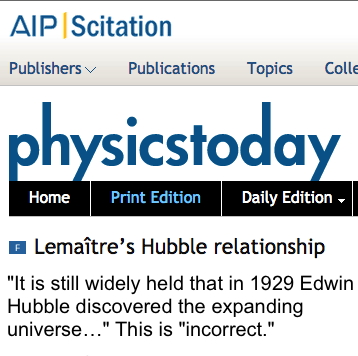 Post-Dating “Expansion” Till Hubble: That the scientific community at large has misattributed, and hence, post-dated, the discovery of the apparent expansion of the universe is readily evident.
Post-Dating “Expansion” Till Hubble: That the scientific community at large has misattributed, and hence, post-dated, the discovery of the apparent expansion of the universe is readily evident.
– space.com 2015: “Hubble discovered the universe was… expanding”
– Cambridge University: receding galaxies first observed by Hubble
– Carnegie Institute for Science: Hubble discovers the universe is expanding
– Bill Nye: Hubble discovered that the stars [sic; galaxies] are moving apart
– Nat’l Geo: “the work of one man… that the whole universe was expanding”
– The History Blog: Hubble traditionally credited with discovering expansion
– Phys.org: “Hubble discovered” that galaxies are moving away from us
– Denver’s PBS: “Hubble discovered that galaxies were moving away”
– Wikipedia: “Hubble’s 1929 discovery that… galaxies… are moving away”
– Sloan Digital Sky Survey: Hubble discovered that the universe was expanding
– BBC Horizon: With expansion Hubble made “the discovery of the century”
– Nasa.gov “Hubble’s 1929 observation that galaxies were generally receding”
– History Channel: The Universe special, see 30-second clip just below
– etc.
Yet even secular science authorities have begun objecting to the systematic misattribution, and hence, post-dating, of the the claim of expansion. Expansion was not a “prediction” of the 1931 big bang theory; it was a 1920s interpretation of both Einstein’s equations and red-shift data.
Corrected Chronology: A correct understanding of the chronology of the observations of apparent expansion is available through:
– Physics Today, The Day We Found the Universe, Princeton’s cosmologist James Peebles
– A Different Approach to Cosmology, Discovering the Expanding Universe
– 1912 Vesto Slipher: The radial velocity of the Andromeda Nebula
– 1917 Willem de Sitter: “The lines in the spectra of very distant stars or nebulae must therefore be systematically displaced towards the red, giving rise to a spurious positive radial velocity” [earliest redshift cosmological hypothesis]
– 1918 Carl Wirtz [translation]: “…the system of spiral nebulae is drifting apart by a velocity of 656 km with respect to the momentary location of the solar system as the center.”
– 1922 Alexander Friedmann: On the curvature of space. [Unlike Einstein’s & Newton’s difficulty in explaining why the universe doesn’t gravitationally implode, Friedmann made an interpretation of general relativity that indicated an expanding universe.]
– 1927 Georges Lemaître: A homogeneous universe of constant mass and increasing radius accounting for the radial velocity of extra-galactic nebulae [1931 English translation in MNRAS], which expansion Lemaître suggests began after a period of time in which the universe was static, which Eddington estimated in 1931 as being originally between a billion and 1.2 billion light years in radius, that is, prior to the beginning of expansion
– 1929 Edwin Hubble: A relation between distance and radial velocity among extra-galactic nebulae, which paper included the “Hubble Law” [called that because Hubble failed to attribute it as Lemaître’s Law]
– 1931 Arthur Eddington: Mentioning in passing Lemaître and the growing belief in an expanding universe, Eddington then presents a few pages of musings on entropy and time and then estimates the fine-tuning of the physics of the universe as more unlikely than one chance in ten raised to the hundredth power. In that paragraph, he states, “Philosophically, the notion of a beginning of the present order of Nature is repugnant to me.” Lemaître seized upon this statement in his very brief letter published two months later in the journal Nature proposing what became known as the big bang theory.
– 1931 Georges Lemaître: big bang proposal in Nature
Hubble Reindicted: Post-dating the “discovery” of the expansion and pre-dating the theory not only helps with the canonical big bang storytelling, as an aside, it also helped to wrongly attribute the “Hubble Law”. As is known today about the famed astronomer:
– Vesto Slipher’s name doesn’t appear in Hubble’s 1929 paper though most of the radial velocities presented were his.
– Hubble wrote to astronomer JH Reynolds asking him to refrain from publishing that which Hubble later published without reference to Reynolds.
– Hubble wrote to de Sitter in 1930, “I consider the velocity-distance relation [i.e., “Hubble’s Law”], its formulation, testing and confirmation, as a Mount Wilson [i.e., Hubble] contribution and I am deeply concerned in its recognition as such.” Clearly.
– The astronomy establishment, Nasa, et al., psychoanalyzes Lemaître and claims that he was humble and did not desire “establishing priority for his original discovery.” So perhaps RSR could be forgiven for trying our own hand at psychoanalysis. Lemaître employed blatant attention getting techniques, like using the name of one of his famous competitors in the opening sentence of his papers. Then in a later paper, Lemaître himself claims credit for this discovery by directly pointing out: “The title of my note [1927 paper] leaves no doubt about my intentions…”
– Hubble and the astronomy establishment have allegedly been “cleared” from the charge of censorship, however the Royal Astronomical Society invited Lemaître to translate for publication paragraphs 1 to 72 of his 1927 paper, with paragraph 73 containing his discovery of the “Hubble” Law.
The need to correct the record is evident by these couple examples, which could be multiplied:
– NASA: The “expanding universe, as predicted by the Big Bang theory.”
– The Exploritorium: “to support the Big Bang theory… observation [shows] that the universe is expanding.”
For the conclusion of this article, please see rsr.org/big-bang-predictions.

